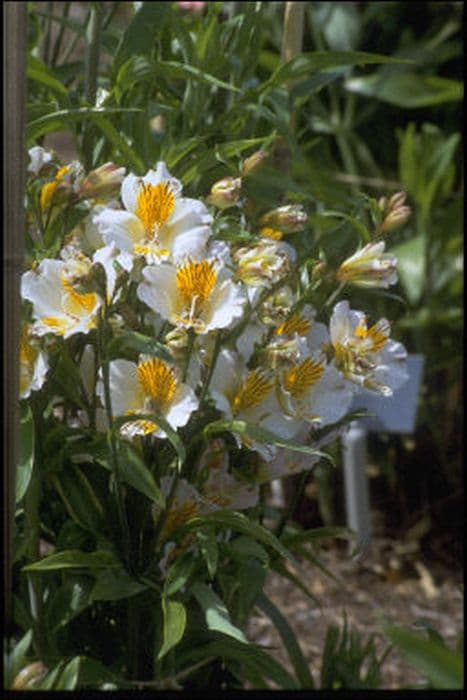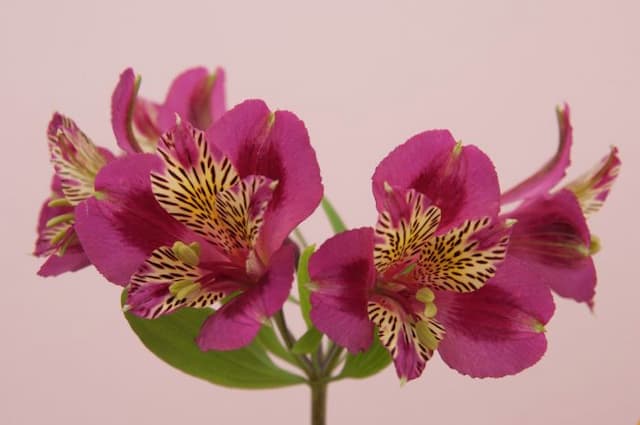Parrot Lily Alstroemeria psittacina 'Royal Star' (v)

ABOUT
The Alstroemeria psittacina 'Royal Star', commonly known as Parrot Lily, is a striking plant known for its unique and vibrant flowers. The blossoms exhibit a blend of pink and burgundy colors, marked with dark streaks and spots that can resemble the plumage of a parrot, hence the name. The petals are often slightly curled and come to a point, flaring out from the center of the flower to create a star-like shape. The Parrot Lily's leaves are narrow and lance-shaped, displaying a bright green color that serves as a beautiful contrast to the vivid flowers. Typically, these leaves twist as they emerge, adding to the plant's ornamental appeal. The flowers are clustered at the top of tall, slender stems, giving the plant an elegant and airy appearance. The overall look of the Parrot Lily is one of exotic appeal and eye-catching color, making it a popular choice for garden enthusiasts who want to add a splash of tropical flair to their outdoor spaces.
About this plant
 Names
NamesFamily
Alstroemeriaceae
Synonyms
Parrot Lily, Parrot Flower, Peruvian Lily, Lily of the Incas
Common names
Alstroemeria pulchella, Alstroemeria psittacina.
 Toxicity
ToxicityTo humans
The plant commonly known as Parrot Lily is not considered highly toxic to humans. However, it contains compounds that can cause mild irritation to the skin, mouth, throat, and stomach if ingested. Symptoms of ingestion may include nausea, vomiting, and diarrhea, though severe poisoning is rare.
To pets
Parrot Lily can be toxic to pets, such as cats and dogs. Ingestion of any part of the plant might lead to gastrointestinal upset, including symptoms like vomiting or diarrhea. If a pet consumes a significant amount of the plant, it is advisable to contact a veterinarian.
 Characteristics
CharacteristicsLife cycle
Perennials
Foliage type
Evergreen
Color of leaves
Green
Flower color
Mixed
Height
2-3 feet (0.6-0.9 meters)
Spread
1-2 feet (0.3-0.6 meters)
Plant type
Herb
Hardiness zones
7
Native area
South America
Benefits
 General Benefits
General Benefits- Attractive Blooms: Alstroemeria psittacina 'Royal Star' is known for its vibrant, orchid-like flowers that can add a splash of color to any garden.
- Long Bloom Period: This plant typically has a long flowering period, providing color from late spring to fall.
- Pollinator Friendly: Its flowers attract bees, butterflies, and other pollinators, enhancing biodiversity.
- Cut Flower: The blooms are long-lasting when cut, making them excellent for bouquets and floral arrangements.
- Drought Tolerance: Once established, it has good tolerance to periods of drought, reducing the need for frequent watering.
- Low Maintenance: Parrot Lily does not require much maintenance, making it an ideal choice for gardeners seeking minimal upkeep.
- Rapid Growth: It can grow quickly once settled, filling in garden spaces efficiently.
- Cold Hardy: It is relatively cold hardy, capable of surviving in cooler climates with appropriate winter mulch.
 Medical Properties
Medical Properties- This plant is not used for medical purposes.
 Air-purifying Qualities
Air-purifying QualitiesThis plant is not specifically known for air purifying qualities.
 Other Uses
Other Uses- Floral Design: Alstroemeria, because of its attractive flowers, is commonly used in bouquets and floral arrangements for events and home decor.
- Photography Subject: Due to its unique patterning and vibrant colors, Alstroemeria makes a great subject for botanical photography.
- Educational Tool: Horticulture and botany programs often use Alstroemeria to teach about plant reproduction and hybridization.
- Landscape Accent: Alstroemeria 'Royal Star' can serve as a colorful accent in landscaping, particularly in borders and rock gardens.
- Gift Plant: The long-lasting flowers of the Alstroemeria make it a popular gift, symbolizing friendship and devotion.
- Artistic Inspiration: Artists sometimes use the plant as inspiration for paintings, drawings, and other forms of art due to its intricate patterns.
- Culinary Garnish: Although not commonly consumed, the vibrant flowers may be used as an ornamental garnish for certain dishes.
- Color Inspiration: Designers might use the color palette of Alstroemeria flowers for color schemes in interior design or fashion.
- Craft Projects: The sturdy stems and flowers of Alstroemeria can be incorporated into craft activities, such as making flower crowns or table centerpieces.
- Symbolic Planting: Alstroemeria can be planted in gardens to symbolize enduring friendship, as each flower has multiple blooms representing the strong bonds between friends.
Interesting Facts
 Feng Shui
Feng ShuiThe Parrot Lily is not used in Feng Shui practice.
 Zodiac Sign Compitability
Zodiac Sign CompitabilityThe Parrot Lily is not used in astrology practice.
 Plant Symbolism
Plant Symbolism- Friendship: Alstroemeria, commonly known as the Peruvian Lily or lily of the Incas, often symbolizes enduring friendships due to its long-lasting nature as a cut flower.
- Devotion: The twisted leaves of the Peruvian Lily are said to represent the trials and challenges in relationships, making the flower a symbol of mutual support and devotion.
- Wealth and Prosperity: With its vibrant blooms, the Peruvian Lily is also seen as a symbol of wealth and prosperity, making it a popular choice for occasions celebrating success and abundance.
- Achieving one's goals: The Peruvian Lily's resilience and ability to bloom in a variety of conditions are emblematic of the determination and effort required to achieve one's goals.
- Mutual Support: The interwoven growth pattern of the Alstroemeria flowers signifies strong bonds and mutual support between people.
 Water
WaterParrot lily should be watered moderately, ensuring the soil is moist but not waterlogged. During the growing season, water once or twice a week with about 1-2 gallons depending on the weather conditions; more during hot, dry periods and less during cooler, wet spells. Reduce watering in fall and winter to once every two weeks or when the soil feels dry to the touch to avoid root rot. It's essential to provide thorough watering that reaches the roots, rather than frequent light sprinkles.
 Light
LightParrot lily thrives in bright, indirect light or partial shade. Avoid direct sunlight during the hot hours of the day, which can scorch the leaves. A spot with morning sunlight and afternoon shade is ideal for the optimum growth and flowering of this plant.
 Temperature
TemperatureParrot lily prefers temperatures between 65 and 80 degrees Fahrenheit. It can survive a minimum temperature of about 50 degrees Fahrenheit but is not frost-hardy. Protect the plant from extreme temperatures and frost to avoid damage.
 Pruning
PruningPruning parrot lily involves removing spent flowers and dead foliage to encourage new growth and maintain a neat appearance. Pruning should be done in late winter or early spring before new growth begins. Deadheading, or removing faded flowers, can also promote a longer blooming season.
 Cleaning
CleaningAs needed
 Soil
SoilParrot lily prefers well-drained soil with rich organic matter and a pH between 6.0 and 7.0. The best mix can be made of two parts loam, one part peat, and one part sand to ensure proper drainage but still retain enough moisture for the plant's needs.
 Repotting
RepottingParrot lilies should be repotted every 2 to 3 years to ensure they have enough room to grow and to refresh the nutrient content of the soil. It is best to repot them in the spring before the new growth begins.
 Humidity & Misting
Humidity & MistingParrot lilies thrive best in moderate to high humidity levels, ideally between 40% and 60%. They are not tolerant of very arid environments and may require additional humidity if grown indoors in drier climates.
 Suitable locations
Suitable locationsIndoor
Parrot lilies need bright, indirect light and consistent watering indoors.
Outdoor
Plant parrot lilies in partial shade and fertile, moist soil.
Hardiness zone
7-10 USDA
 Life cycle
Life cycleAlstroemeria psittacina 'Royal Star', commonly known as Peruvian Lily or Parrot Lily, begins its life as a rhizome that sprouts stems and leaves in the spring. The plant then forms underground tubers that store energy for the next growing season. Following vegetative growth, the Peruvian Lily produces colorful, spotted flowers typically in the summer months, which attract pollinators for reproduction. After pollination, the flowers will develop into capsule-like fruits containing seeds. Once the seeds are dispersed, they may germinate to produce new plants, or the plant will rely on its tubers to regrow the next season. The Peruvian Lily then enters dormancy in winter, where the above-ground parts die back, and the cycle begins anew with the rhizome in spring.
 Propogation
PropogationPropogation time
Spring-Early Summer
Alstroemeria psittacina 'Royal Star', commonly known as Parrot Lily, is best propagated through division, which can be done in the spring as new growth appears. To propagate by division, gently dig up the clump of rhizomes and separate them, ensuring that each division has at least one eye, or bud. Replant the divisions at the same depth they were growing previously, spacing them about 12 inches (approximately 30 centimeters) apart. Care should be taken not to damage the fleshy roots during the process. After replanting, water the divisions thoroughly to help establish them. Division allows the plants to rejuvenate and can help encourage more vigorous growth and flowering.





![Peruvian lily [H.R.H. Princess Alice]](/_next/image?url=https%3A%2F%2Fplants-admin.emdemapps.com%2Fimages%2Fplants%2F%2Fimages%2F604b55e81c8b0.png&w=640&q=75)

![Peruvian lily [Inca Coral]](/_next/image?url=https%3A%2F%2Fplants-admin.emdemapps.com%2Fimages%2Fplants%2F%2Fimages%2F604b5b79b85ce.png&w=640&q=75)
![Peruvian lily [Inca Exotica]](/_next/image?url=https%3A%2F%2Fplants-admin.emdemapps.com%2Fimages%2Fplants%2F%2Fimages%2F604b5ec0e34a9.png&w=640&q=75)
![Peruvian lily [Inca Milk]](/_next/image?url=https%3A%2F%2Fplants-admin.emdemapps.com%2Fimages%2Fplants%2F%2Fimages%2F604b5f14b0b6a.png&w=640&q=75)